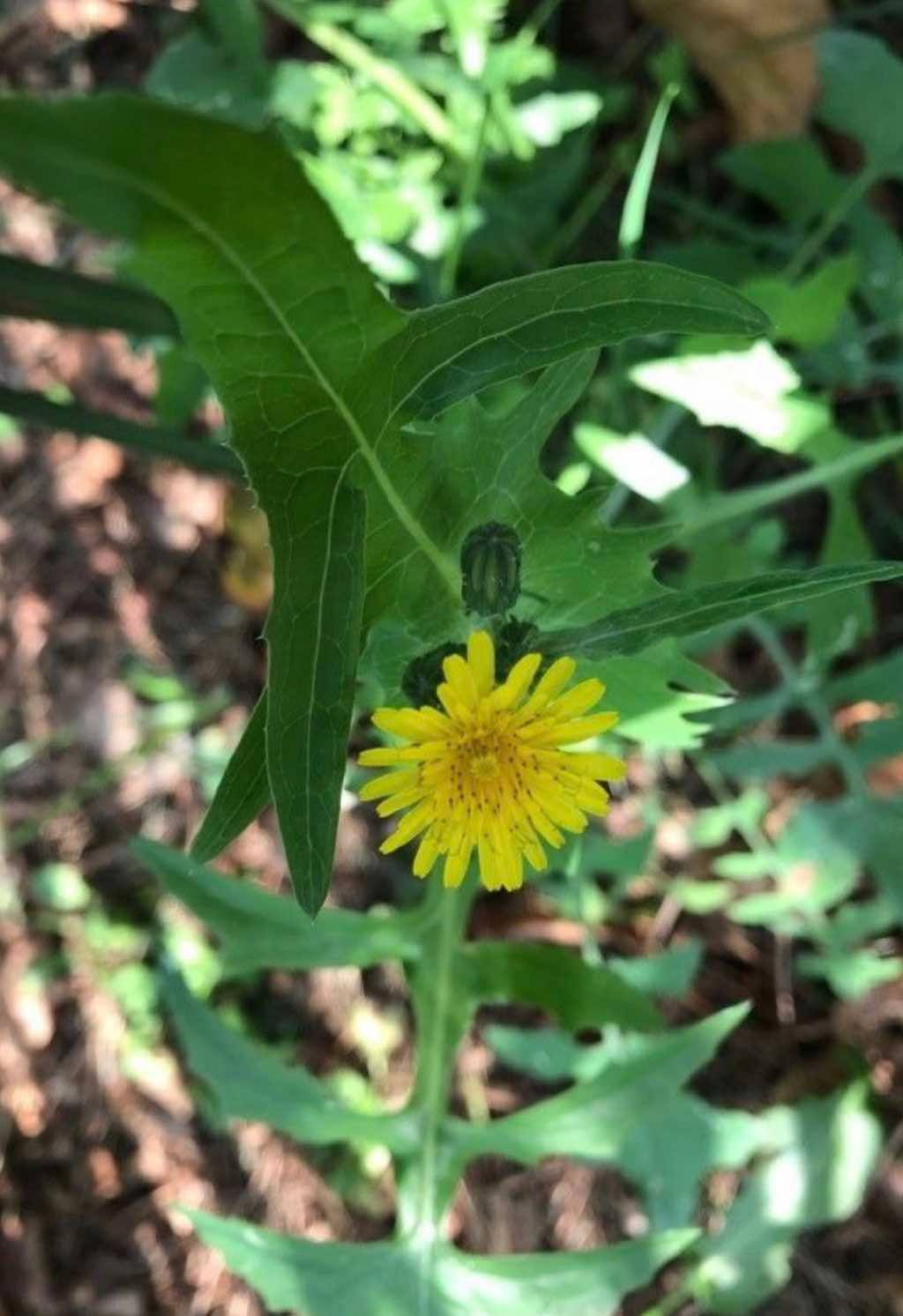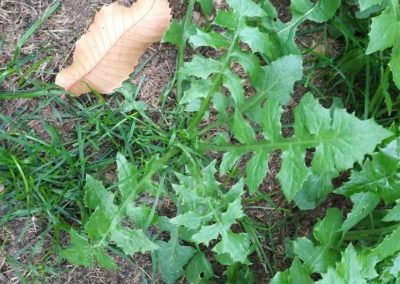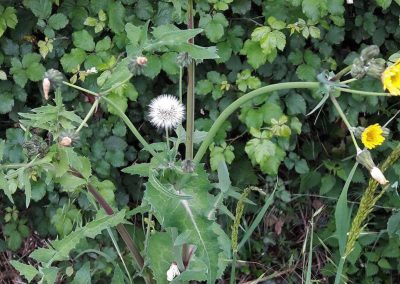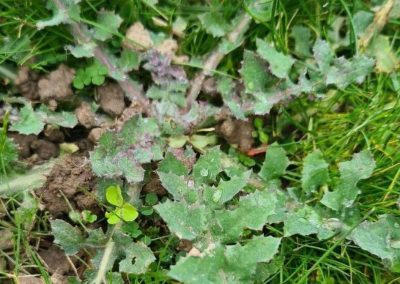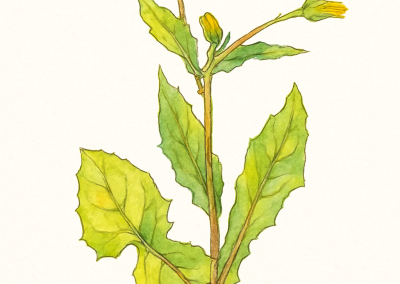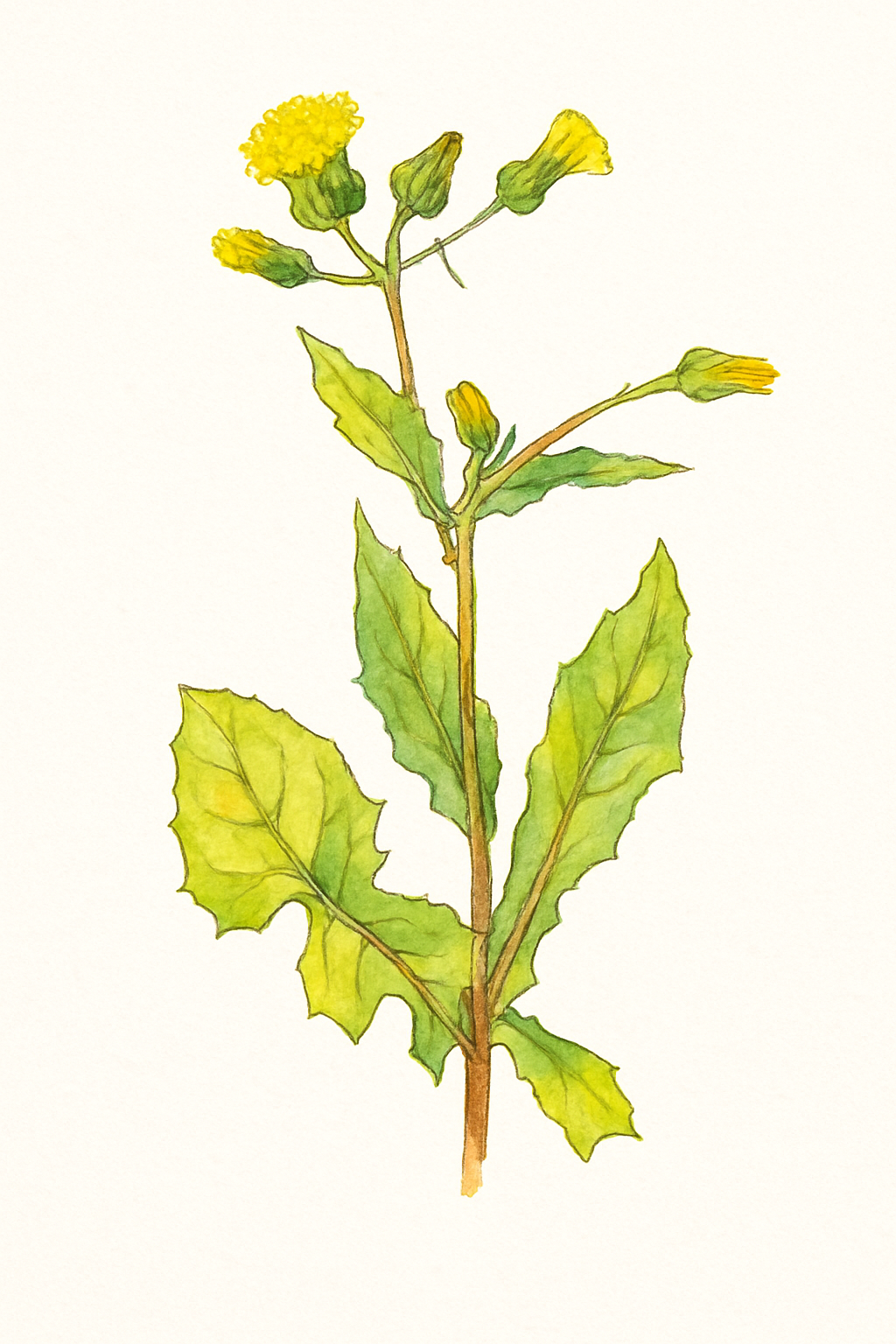Sonchus oleraceus
Scientific description
Scientific name: Sonchus oleraceus
Kingdom: Plantae
Syntax: Magnoliophyta
Taxonomy: Dicotyledons (Magnoliopsida)
Order: Asterales
Family: Asteraceae
Genus: Sonchus
Species: Sonchus oleraceus
Origin:
Also known as common sow thistle, believed to have originated in Europe and Asia. Now widespread in North America, Australia, New Zealand; considered a weed due to adaptability and prolific seed production. In Greece, five species exist and are collected when tender.
Ecology:
Highly adaptable; found in agricultural lands, gardens, roadsides, urban areas.
Description:
Annual herb, 30–150 cm tall. Hollow erect stems may exude milky sap. Lobed, spiny-edged leaves, alternately arranged. Basal rosette of lower leaves; upper leaves clasp stem. Yellow, dandelion-like flowers (~2 cm), spring to autumn, clustered at branch ends. Seeds with pappus for wind dispersal.
Propagation:
Primarily by seeds; thousands per plant, easily dispersed by wind, water, animals, humans. Rapid germination allows multiple generations per season; seeds can remain viable for years.
Uses:
Edible young leaves for humans; dried seeds for birds. Known since ancient times as "sochos" (Theophrastus). Medicinal: diuretic, anti-inflammatory, wound and fever treatment. Mapuche of Chile used as antipyretic and hemostatic. Rich in vitamins C and K. Nectar source for pollinators. Culinary, medicinal, fodder, and green manure applications.
ΖΟΧΟΣ (Σόγχος ο λαχανώδης)
Βασίλειο: Φυτά (Plantae)
Συνομοταξία: Αγγειόσπερμα (Magnoliophyta)
Ομοταξία: Δικοτυλήδονα (Magnoliopsida)
Τάξη: Αστερώδη (Asterales)
Οικογένεια: Asteraceae
Γένος: Σόγχος (Sonchus)
Είδος: Σόγχος ο λαχανώδης (Sonchus oleraceus)
Καταγωγή:
Πιστεύεται ότι προέρχεται από Ευρώπη και Ασία. Εξαπλωμένο σε Β. Αμερική, Αυστραλία, Νέα Ζηλανδία, κυρίως ως ζιζάνιο λόγω προσαρμοστικότητας και παραγωγής σπόρων. Στην Ελλάδα υπάρχουν 5 είδη, συλλέγονται τρυφερά.
Οικολογία:
Ευπροσάρμοστο, σε γεωργικές εκτάσεις, κήπους, άκρες δρόμων και αστικές περιοχές.
Περιγραφή:
Ετήσιο βότανο, 30–150 cm. Κοίλο, όρθιο στέλεχος με γαλακτώδη χυμό. Λοβωτά, αγκαθωτά φύλλα, εναλλασσόμενα. Κατώτερα σε ροζέτα, ανώτερα σφίγγουν στέλεχος. Κίτρινα άνθη, ~2 cm, Άνοιξη–Φθινόπωρο, σε συστάδες. Σπόροι με pappus για διασπορά με άνεμο.
Πολλαπλασιασμός:
Κυρίως με σπόρους, χιλιάδες ανά φυτό, διασκορπίζονται εύκολα με άνεμο, νερό, ζώα, ανθρώπους. Ταχεία βλάστηση, πολλαπλές γενιές ανά σεζόν, σπόροι βιώσιμοι χρόνια.
Χρήση:
Νεαρά φύλλα για ανθρώπους, σπόροι για πουλιά. Γνωστό από αρχαιότητα ως "σόγχος" (Θεόφραστος). Φαρμακευτική χρήση: διουρητικό, αντιφλεγμονώδες, πληγές, πυρετός. Ιθαγενείς Mapuche: αντιπυρετικό, αιμοστατικό. Πλούσιο σε βιταμίνες C & K. Νέκταρ για επικονιαστές. Κουζίνα, φαρμακευτικά, ζωοτροφή, χλωρή λίπανση.
Nom scientifique : Sonchus oleraceus
Règne : Plantae
Syntaxe : Magnoliophyta
Taxonomie : Dicotylédones (Magnoliopsida)
Ordre : Asterales
Famille : Asteraceae
Genre : Sonchus
Espèce : Sonchus oleraceus
Origine :
Également appelé laiteron des champs, originaire d’Europe et d’Asie, maintenant présent en Amérique du Nord, Australie, Nouvelle-Zélande. Répandu comme mauvaise herbe. En Grèce, cinq espèces, récoltées tendres.
Écologie :
Très adaptable; terres agricoles, jardins, bords de route, zones urbaines.
Description :
Herbe annuelle, 30–150 cm. Tige creuse, exsudant parfois sève laiteuse. Feuilles lobées, bordées d'épines, alternes. Rosette basale des feuilles inférieures; supérieures embrassent tige. Fleurs jaunes type pissenlit (~2 cm), printemps–automne, en grappes terminales. Graines avec pappus pour dispersion.
Propagation :
Par graines, milliers par plante, dispersées par vent, eau, animaux, humains. Germination rapide, cycles multiples, viabilité plusieurs années.
Utilisations :
Feuilles jeunes comestibles; graines séchées pour oiseaux. Connu comme "sochos" (Théophraste). Médicinal: diurétique, anti-inflammatoire, plaies, fièvre. Mapuches Chili: antipyrétique, hémostatique. Vitamines C & K. Nectar pour pollinisateurs. Culinaire, médicinal, fourrage, engrais vert.
Sonchus oleraceus (Lăptuca sălbatică / Păpălăuga)
Regn: Plantae
Diviziune: Magnoliophyta
Clasă: Dicotiledonate (Magnoliopsida)
Ordin: Asterales
Familie: Asteraceae
Gen: Sonchus
Specie: Sonchus oleraceus
Origine:
Cunoscută ca lăptucă sălbatică, crede-se că provine din Europa și Asia. Răspândită în America de Nord, Australia, Noua Zeelandă; buruiană datorită adaptabilității și producției mari de semințe. În Grecia, 5 specii culese fragede.
Ecologie:
Extrem de adaptabilă; terenuri agricole, grădini, margini de drum, zone urbane.
Descriere:
Plantă erbacee anuală, 30–150 cm. Tulpină goală, erectă, exudând latex alb. Frunze lobate, cu margini spinoase, alternante. Rosetă la bază pentru frunzele inferioare, superioare îmbrățișează tulpina. Florile galbene (~2 cm), primăvară–toamnă, grupate terminal. Semințe cu pappus pentru dispersie.
Înmulțire:
Prin semințe, mii per plantă, dispersate de vânt, apă, animale, oameni. Germinare rapidă, cicluri multiple, viabilitate ani de zile.
Utilizări:
Frunze tinere comestibile, semințe uscate pentru păsări. Cunoscut din Antichitate ca "sochos" (Teofrast). Medicinal: diuretic, antiinflamator, plăgi, febră. Poporul Mapuche: antipiretic, hemostatic. Vitamine C & K. Nectar pentru polenizatori. Culinar, medicinal, furaj, îngrășământ verde.
Creative writing inspired by Sonchus oleraceus
Sonchus oleraceus — Zochos
In ancient times, there was a humble but brave young man named Zochos. He lived in a small village surrounded by vast fields and hills. Zochos, though of simple origins, had a heart full of courage and compassion. He was known to care for the weak and the sick, often seeking remedies in the plants that grew wild around him.
One year, a great war broke out, and many of the village's young men were called to fight. Zochos, though not a soldier, wanted to help heal the wounded. With no formal training, he turned to the wild herbs he knew so well. In his quest to find the most potent healing plant, he discovered a robust, leafy weed with delicate yellow flowers—Sonchus oleraceus, the sow thistle.
Zochos collected the leaves and used them to treat the injuries of many soldiers, noticing that the plant had both nourishing and medicinal properties. Word spread of his miraculous cures, and even the gods took notice. Athena, goddess of wisdom, appeared to Zochos and offered to grant him great knowledge of healing in exchange for his devotion to her. However, Zochos humbly declined, believing that the knowledge of the earth’s healing powers belonged to all people, not just to one individual or god.
Athena, impressed by his humility, blessed the plant that Zochos had discovered. From that day, sow thistle became revered for its healing powers, strength, and resilience. The people named it Zochos in his honor, and it became a symbol of healing, humility, and the unbreakable bond between humanity and nature.


